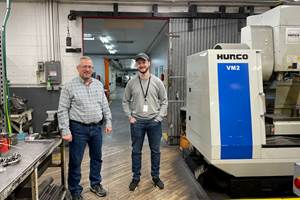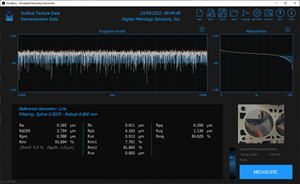VIDEO: What Does Integrated Predictive Modeling Mean to Moldmaking
Although conformal cooling is not a new concept, new technologies have made it a very hot topic, including predictive engineering models and 3D printing. Learn about a new conformal cooling process and algorithm and what it reveals about hot spots and conformal cooling design.
Zakary Smith, founder and CEO of Instaversal, discusses how shops can optimize their conformal cooling processes by using predictive modeling to detect hot spots.
Transcript
Instaversal is a product development ecosystem bringing together the future of conceptualization to mass production of various products, including embedded firmware of electromechanical devices. In the process of providing product development consulting, we actually develop our own products as well, in areas such as advanced manufacturing, additive manufacturing, cloud computing and artificial intelligence.
Instaversal comes from “instant” and “universal,” which is our guiding light with what we do with our customers. We're trying to provide instantaneous service and solutions with a universal approach. This is directly applicable to one of our products that we're going to go into more detail about today, Cool Tool, which is really intended to provide a solution to all mold makers and molding shops across the globe.
Conformal cooling has been around for over a decade. Unfortunately, it's not a new technology, but it still hasn't lived up to the hype. It's been around for a while and is not being adopted. When we set out to produce Cool Tool, it was built around the hypothesis of a few things, specifically with a problem in mind. People don't know which parts are a good fit for conformal cooling. Even if they know what is a good fit, they are not really well suited with the tools to design conformal cooling channels that could perform from a thermal perspective and a production perspective with regard to additive manufacturing. And then even validating the performance improvement is really a black box. So with regard to Cool Tool, we actually are able to address all three of those issues.
With regard to the three areas we just discussed, the first is predictive engineering modeling and how it can be leveraged to define how to pull the heat out of the process to cool the part as quickly as possible. One of our lead engineers has over 40 U.S. and international patents. And we're actually leveraging technology used for the semiconductor manufacturing equipment space into conformal cooling with additive manufacturing. So we're able to identify with a generative design process how you can lower the cooling time as much as possible with additive manufacturing. So before you even decide that you want to move forward, we could guarantee the improvement from a return-on-investment perspective on cycle time.
The second area is you could do predictive engineering modeling and have a design in theory that cools a part well but isn't actually manufacturable. I have a demonstration part of what we're doing on the software design side to enable a printable cooling channel. So auto-routing, as it relates to cooling, has been around for a while. We actually take mathematical models as it relates to printability. So if you think of the inclination angle as it relates to the normal plane of the print, we could change the profile of the cooling channels to make sure it's printable. So not only is it improving the thermal performance, but that design will be directly transferable into a principal part and seamlessly go from concept to production.
The third part with regard to our hypothesis on the adaptation of conformal cooling is validating the improvement. One of the company's core values is transparency, and we're working to provide a transparent cost model, from the OEM to the part producer to the mold maker. We do that through machine monitoring, validating the cycle times on parts. And even looking at process parameters and using artificial intelligence to define if that process is going out of sync before it happens to make sure you get the process back under control.
We're really excited with regard to this print because, alongside international mold steel and their HTC45 material, which is essentially traditional H13 but leveraged for 3D printing, it actually has better thermal conductivity. So if you're trying to reduce your cooling times, it's the perfect fit. It also performs well with printability; there's no cracking, and we're looking at a million cycles with this material.
If you're working with injection molded parts where cycle time is really important, or you're dealing with critical dimensions and tolerances, it's a really good fit, Cool Tool because we're able to control both the time-costs relationship and the dimension-tolerance relationship as it relates to pulling heat out of the park. In the past, it's been really challenging to tie all the steps together to both optimize and produce 3D metal printed and cooled insert. And we're here to help at any stage of the process to make it easy and seamless for your process, whether you're a mold maker, a part manufacturer, or purchasing injection molded parts.
Related Content
Midgard Inc. Tackles Tooling Challenges and Automates Production to Keep Molds Running
This Eastern Pennsylvania molder does cavity changes daily, making its in-house toolroom critical to quickly fixing mold problems.
Read MoreWhat Does Surface Roughness Mean in Moldmaking?
To improve mold performance, reduce wear and produce high-quality molded parts, mold builders must understand surface texture and how to properly measure, analyze and control it.
Read MoreProducts and Services for Multiple Moldmaking Needs
New year, new technology roundup! Featured here is a collection of product offerings, from profile milling cutters to industry-specific CAD/CAM software to innovative hot work tool steels.
Read MoreUsing CT Scanning to Qualify Molds Faster
Software and hardware advances reduce dimensional inspection with part-to-CAD by 70%.
Read MoreRead Next
How to Use Continuing Education to Remain Competitive in Moldmaking
Continued training helps moldmakers make tooling decisions and properly use the latest cutting tool to efficiently machine high-quality molds.
Read MoreReasons to Use Fiber Lasers for Mold Cleaning
Fiber lasers offer a simplicity, speed, control and portability, minimizing mold cleaning risks.
Read MoreAre You a Moldmaker Considering 3D Printing? Consider the 3D Printing Workshop at NPE2024
Presentations will cover 3D printing for mold tooling, material innovation, product development, bridge production and full-scale, high-volume additive manufacturing.
Read More










.jpg;maxWidth=300;quality=90)




_300x250 3.png;maxWidth=300;quality=90)










